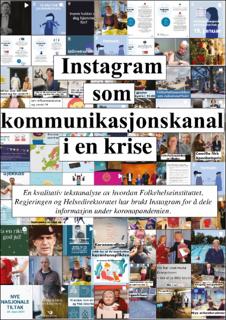| dc.contributor.advisor | Selstø, Ragnhild Sofie | |
| dc.contributor.author | Drottning, Astri | |
| dc.date.accessioned | 2021-09-03T16:33:18Z | |
| dc.date.available | 2021-09-03T16:33:18Z | |
| dc.date.issued | 2021 | |
| dc.identifier | no.uis:inspera:80220904:35016442 | |
| dc.identifier.uri | https://hdl.handle.net/11250/2773453 | |
| dc.description.abstract | Med Instagram som et av de største sosiale mediene i Norge, er dette en viktig plattform å være på for å få ut informasjon. Instagrams flittigste brukere er i aldersgruppen 18-29 år og flertallet av brukere er kvinner. Kvinner i denne aldersgruppen er også overrepresentert når det kommer til lavt nyhetskonsum, noe som har blitt omtalt som et demokratisk problem. Til tross for omfattende dekning og informasjon om koronaviruset, viser forskning at mennesker med lavt nyhetskonsum i stor grad ikke nås via tradisjonelle nyhetsmedier. For Regjeringen, Helsedirektoratet og Folkehelseinstituttet er det derfor viktig å ha en sterk tilstedeværelse på Instagram.
Ved å utføre en kvalitativ tekstanalyse av Instagram-innleggene til Regjeringen, Helsedirektoratet og Folkehelseinstituttet søker denne oppgaven å besvare hvordan de har brukt sine plattformer til krisekommunikasjon under koronapandemien. Grunnlaget for å kunne besvare problemsstillingen ligger i valg av bilde og tekst, hvordan de har brukt emoji og emneknagg, antall likerklikk og hvordan de håndterer kommentarer. En samlet analyse av de ulike kontoene vil i tillegg belyse hvor aktive de har vært i perioden.
Funn fra oppgaven viser blant annet at undersøkelsesobjektene har lagt ut flest innlegg som kan kategoriseres som informasjon. Alle har brukt retorikk som virkemiddel, men varierer i bruk av patos og logos. De fleste undersøkelsesobjektene bruker Instagram som et supplement til nettsider, og henviser istedenfor til nettsiden. Bare Folkehelseinstituttets kontoer hadde en konsis toveiskommunikasjon og svarte på majoriteten av spørsmål og kommentarer i kommentarfeltet. | |
| dc.description.abstract | Instagram, being one of the largest social media platforms in Norway, is an important platform to spread information. The platform's most diligent users are young people between 18 to 29 years old, the majority being women. Women in this age are also overrepresented when it comes to low news consumption, which has been described as a democratic problem. Despite extensive coverage and information about the coronavirus, research shows that people with low news consumption are largely unreachable via traditional news media. For the Norwegian Government, the Norwegian Directorate of Health and the Norwegian Institute of Public Health, it’s therefore even more important to have a strong presence on Instagram.
By performing a qualitative text analysis of the Instagram posts of the Norwegian Government, the Norwegian Directorate of Health and the Norwegian Institute of Public Health, this study seeks to answer how they have used their platforms for crisis communication during the corona pandemic.
The foundation for being able to answer the research question in this bachelor thesis, lies in the choice of image and text, how they have used emoji and hashtag, the number of likes and how they handle comments. An overall analysis of the various accounts will also shed light on how active they have been during the period.
Findings from the thesis show, among other things, that the category “information”, is the most used in posts. They have all used rhetoric as a tool, but they vary in the use of pathos and logos. The majority of the survey objects use Instagram as a supplement to their own websites, and refer to this in various Instagram posts. The Norwegian Institute of Public Health’s accounts were the only ones who had a concise two-way communication and answered the majority of questions and comments in the comments field. | |
| dc.language | nob | |
| dc.publisher | uis | |
| dc.title | Instagram som kommunikasjonskanal i en krise.
En kvalitativ tekstanalyse av hvordan Folkehelseinstituttet, Regjeringen og Helsedirektoratet har
brukt Instagram som kommunikasjonskanal under koronapandemien. | |
| dc.type | Bachelor thesis | |
